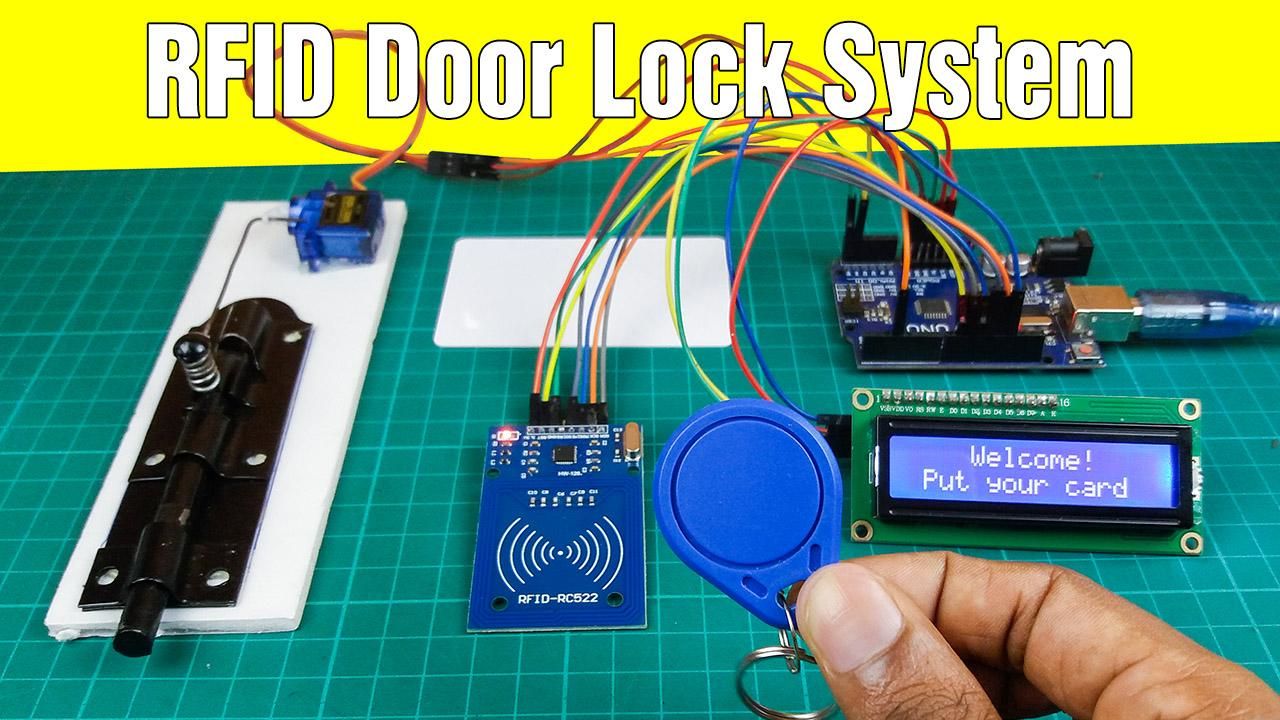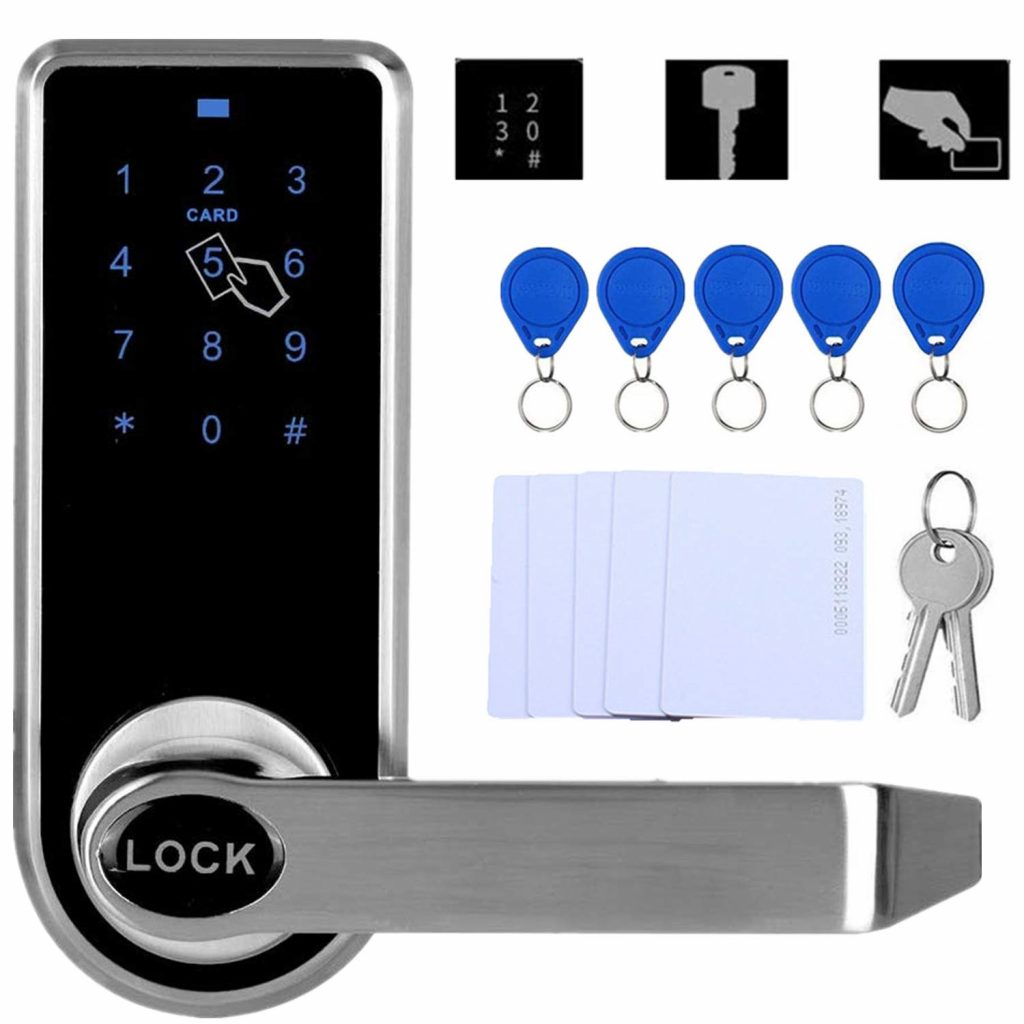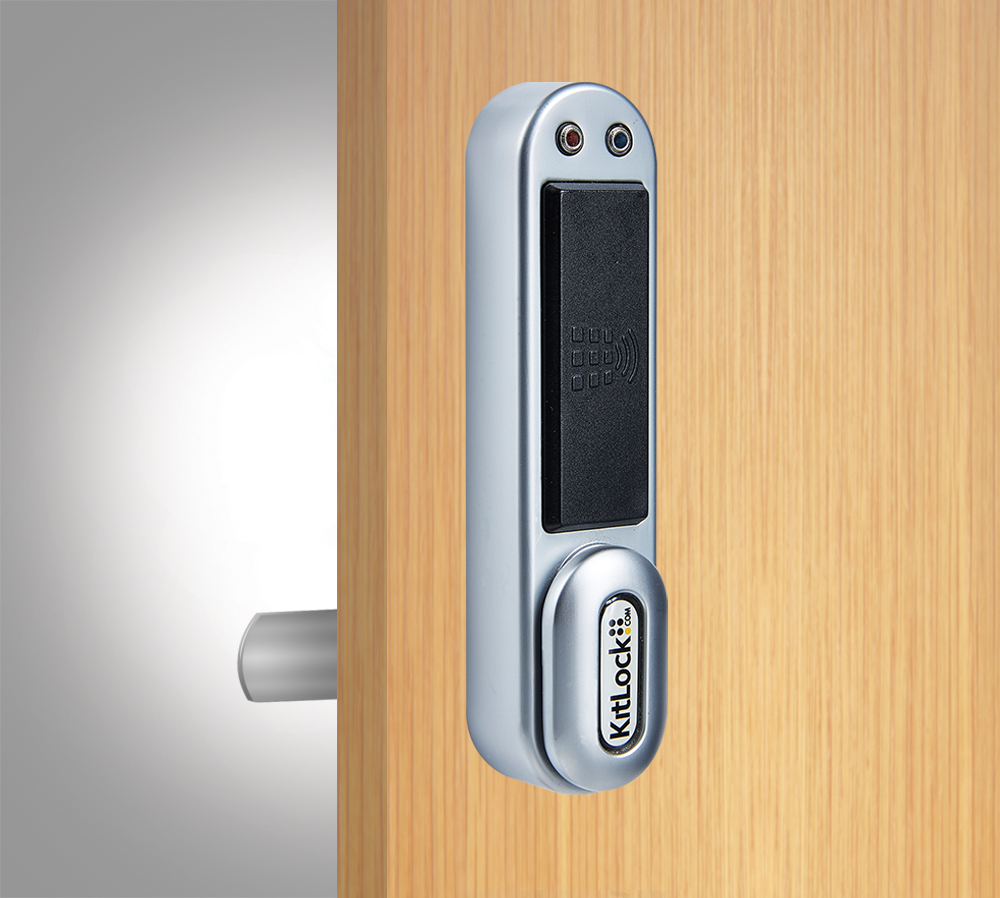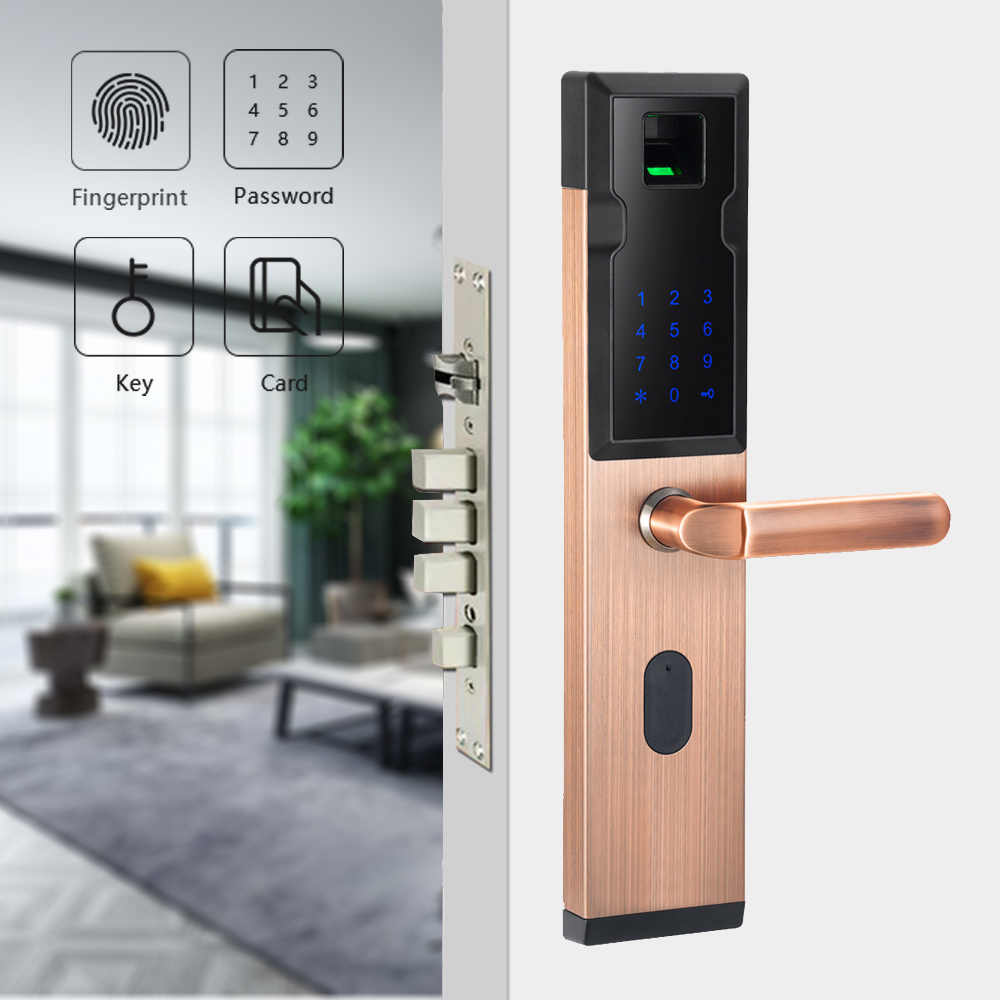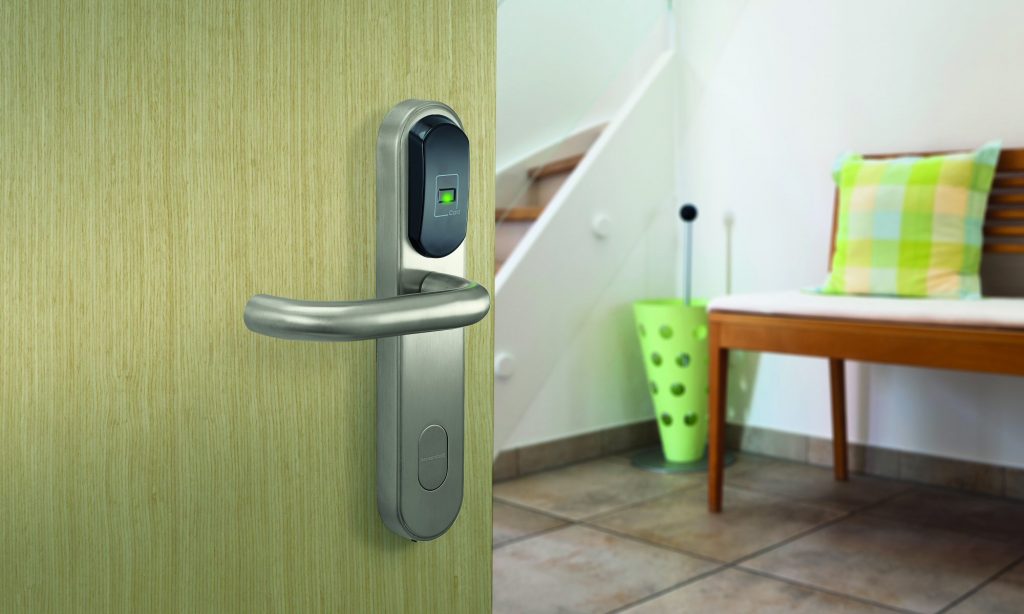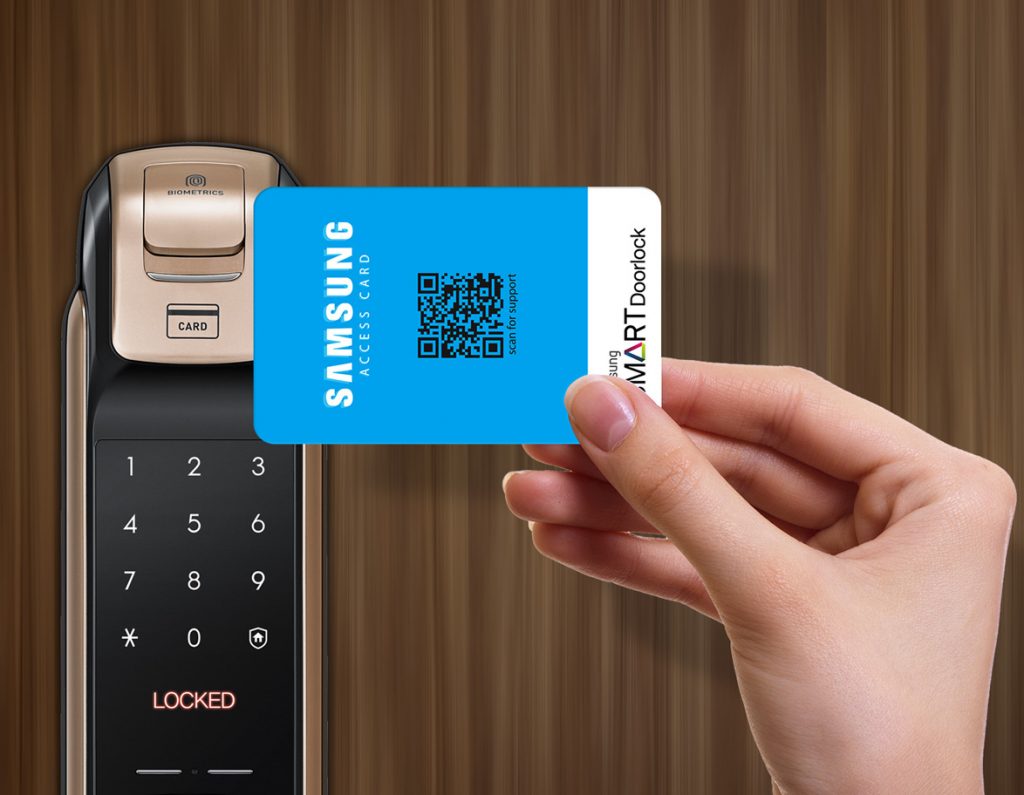Best RFID door locks allow making your house more secure.
Not all RFID door lock models are good enough for maximum security. Only the best of the best devices give your residence reliable safety.
It’s difficult to separate the worse from the better. To make it easier for yourself, you should pay attention to the most important features of a door lock:
- Reprogrammable RFID Key Cards. High-quality RFID lock models always have these. A reprogrammable RFID card makes access to the door much easier. House owners don’t have to make a new RFID card set if they want to add a new user to the list.
- Break-in Protection. A door lock should have security features for preventing break-ins. They’re rare, but still can happen and you should be ready for them. To effectively prepare for a potential robber’s visit, you should understand these measures fully.
- Mobile App. Most of the RFID door lock models are accompanied by an app that’s installed on your smartphone. It’s important to research this app first. The app should be easy and comfortable to use, otherwise, it’ll be really difficult to use your lock.
This article explains everything you need to know about RFID door locks, what are they, and how they work. Check a list of the pros and cons of some lock models as well as their alternatives.
What is an RFID door lock?
RFID means Radio Frequency Identification. RFID door lock is an electronic lock that gives you access by RFID tags.
Some examples of RFID usage are pretty surprising. Logistics firms require it to monitor the movement of their cars, trains, and airplanes. Even common farmers use RFID tags to work with their cattle.
Compared to the NFC door locks
Unlike more common NFC door locks RFID uses electromagnetic fields that bide tags and readers.
RFID technology made itself very useful with a flexible and innovative way for a wireless connection.
RFID smart lock installation
You can choose different configurations for RFID locks depending on the specific model.
Some RFID door locks have a physical deadbolt, so traditional keys can be used. But other RFID locks work with digital credentials only.
RFID door lock is installed on entrance doors or the doors that lead to amenity spaces. Those who use RFID for business security can give keycards to each employee.
3 Components For the RFID Locks to Work Properly
- RFID transponder. An RFID door lock tag is a tiny mechanical part, a small device storing a unique set of computer data. It’s a piece of information used as a verification of the identity of the user. This transponder is usually a part of a credential, such as a fob or a card.
- Credentials reader. They receive data from your credential before the control panel. The most crucial part of this device is an antenna. It provides the communications between it and the RFID tag.
- Control panel. It’s a thinking core of the entire RFID door lock system. They store an informational base that contains all credential data, compare it with a received one and decide if they match. Lock owners can also use this device to change access permissions as they like.
How do RFID door locks work?
RFID locks use radio waves. It provides a more secure data exchange. They construct a bridge between a credential and the RFID reader. The attendant presents the credential to the reader, and then it is decided if they obtain the rights of access.
An RFID door locks work when an administrator runs and programs it. System admins also can delete credentials if the user lost their card.
Best RFID door locks are really similar to smart locks, especially in the way they both function. They’re both wireless and almost completely electronic.
Sometimes RFID door lock is called a smart lock for this reason. Still, there are differences that don’t make this strictly right.
Smart locks use an internet or Bluetooth connection and can be unlocked via a mobile phone app. RFID locks require using a physical device such as a fob or a key card and using radio waves.
How to use your RFID door lock
- Show the credential to the reader. A specific way to do this depends on the RFID lock model. Usually, you should physically insert the key or the fob into the RFID reader. But the best RFID door locks are using a touchless entry.
- Wait for the reader to receive the credential. Your credential makes use of radio waves to send a string of your data to the reader.
- Wait until the control panel verifies the credential. A reader sends the credential information to the control panel. The data sent is compared to the one in the digital database.
- The control panel should have opened the lock. If the data in the base and in the credential have matched, the control panel sends a signal to the door lock for it to open.
RFID door lock access control system types
RFID locks have a wide range of use. Therefore there are a lot of different types of RFID devices. There are three most common types of RFID frequencies:
- Low frequency (LF). These RFID access control door lock readers operate at a frequency of 125 kHz. The read distance is very small: around 10 cm. That requires the credential to be very close to the sensor to be read. But there are quite a few upsides. The low proximity of the low-frequency RFID makes interference from other sources extremely rare. This makes LF door lock very popular, especially among those who pursue maximum security for their business or commercial offices. With them, it isn’t hard to stay close to the reader when presenting your credentials. If the distance between the RFID tag, the reader, and the entry is bigger than in an office, an LF lock isn’t the best option.
- High frequency (HF). For commercial RFID doors, it’s the most popular type of lock system. These readers operate at a frequency of 13.56 MHz. Their operating range starts at 10 cm and goes up from 1 m, which makes them the most versatile locks compared to the other two types. When using high-frequency RFID in a business office, the biggest upside is that the reading distance can be configured for your needs, based on the layout of the room. NFC door locks use the same frequencies as HF locks. High-frequency RFID door lock models are commonly compatible with NFC locks.
- Ultra-high frequency (UHF). This RFID technology’s operating frequency is around 900 MHz. They have an extremely long reading range: up to 100 m, which may differ depending on the type of credential. Reading speed is also the fastest. A big downside of this is that the long reading range makes the chance of interference very high. Thus, UHF smart locks require proactive and regular management if they are to function reliably. If you make this choice you should be aware that there are significant security risks if someone tries to intercept RFID door locks data.
There are also three existing types of RFID credential tags. They function in different ways.
- Active tags. They constantly send out a signal, which requires them to have a long-lasting power supply; a battery, usually. They have a built-in antenna. With it, they receive or transmit radio waves from nearby reading devices as well as the other tags. These tags also support data reading and writing, so they can be used for logging and documentation.
- Semi-active tags. These require battery energy as well, to support the work of their integrated circuitry. That’s why they have another name: Battery-Assisted Passive (BAP) tags. They don’t send any waves until they are within range of an RFID door lock system reader device. When they receive a signal from the reading RFID machine, the battery inside the tag powers on and enables communication for the door to open.
- Passive tags. They don’t require any internal power sources. To get some energy, they use the RFID lock’s magnetic fields. This way they induce a current in the tag’s antenna. This type of tag is the least expensive out of the three.
RFID technology pros & cons
As there are benefits of this technology, there are also many disadvantages that may outweigh them. To make a decision, you should be aware of both pros and cons of RFID access control systems.
RFID locks pros
There are lots of benefits that make RFID such a popular security system among commercial and business residents. It’s much safer and more secure than traditional locks with physical metallic keys. This way of protecting your office is very comfortable to use.
Contactless verification
RFID technology uses radio waves to send and receive data. You don’t have to swipe a card into the reader or enter some sort of key. Entry is completely touchless, and that is very convenient for users.
A touchless entrance is more effective. For daily use, it’s much better, and more comfortable for office employees. Using it allows for improving their quality of life during their work while securing the building even better than before.
Simple configuration
With RFID devices, you don’t have to make new keys or retool the door lock itself. You just have to digitally reconfigure your RFID access control system or an NFC door lock. Even a small change in the settings isn’t a problem anymore. You can easily reprogram your security system at any time of the day.
Although it sounds convenient, if you’re using an on-premise RFID digital door lock, your settings are stored on local servers. They require a system administrator and a technician to manually install all the updates as well as to manage the database.
But this problem disappears if you use a cloud-based system. All changes are added remotely and are instantly applied to your database. Software updates are also installed instantly in this case. They run as soon as they become available to users.
Higher security
RFID credentials are greatly encrypted. This is true for most modern tags, such as cards or key fobs. It makes the lock much more reliable and safe. Old tag models and swipe cards can be cloned without many problems. But DESFire EV2 128-bit AES cryptographic cards come with digitally signed identifiers. This makes them very difficult, almost impossible to copy. Criminals who want to commit a break-in are thus prevented from catching signals or playing with data.
Camera surveillance
RFID security systems support the installation of video cameras at the reader entry. It’s a nice addition to the overall protection because it allows us to visually monitor what happens during the verification. Most security incidents and crimes occur at the door, so it’s an important point.
Video surveillance plus access control gives an opportunity to fully monitor the identity of a visitor, mitigate tailgating and see who’s attempting to visit. This opportunity can be realized by the owner of the lock from anywhere.
Many deployment options
RFID chips are small. This makes them easy to embed in different devices. Thus, the variety of access methods is very vast. You can use ID badges, key cards, and fobs.
A nice bonus is that RFID readers come in different designs. Some are slim and can fit in narrow places while giving the same functionality without losing quality compared to RFID readers of a standard size.
RFID devices are easily scalable to fit new entrances or rooms. All of the configurations are made through remote access control software.
High awareness
Data is read and stored on the RFID device itself. This makes RFID door locks not only a security measure but also a tool for analytics convenient for any type of business. The access control system stores all logging activity as well as all communications with tags.
RFID system track each user’s authorized entry and failed attempts. Owners have all the information about who enters the facility, through which door, and when the entry occurred. This can be used to further increase security.
Low maintenance costs
This is one of the most prevalent reasons why RFID technology became so popular in commercial residences. Key fobs and cards can be easily reprogrammed. You don’t have to buy new credentials, just reconfigure old ones for new purposes.
Even if you need new RFID credentials, they’re quite cheap. You can also save some money by ordering them in bulk. If the card reader needs a system update, you don’t have to replace any physical components of the device.
Service fees vary depending on the provider, size of the department, model, and required configurations. But RFID devices always stay a cost-effective security system.
RFID door lock cons
It’s easy to lose credentials
This problem is the same as with classic metallic keys. Attendants can sometimes lose their credentials. A fob or an RFID card is easy to use, but also easy to lose. The chances of something like this happening are relatively high.
When the credential is lost, residents have to spend some of their time replacing the fob. The time that has to be taken from their business schedule. This makes using RFID tags much less convenient than it may seem at a first glance.
Insecurities
Sadly, RFID door locks can be hacked. Even more so, issuing fake RFID credentials is much easier than making a copy of a traditional key. Simple online research reveals that you can order your own RFID copying machine for just $15. This fact drastically increases the risk of a security breach on your residence when you use an RFID access control system.
You can’t manage visitors
Management is very important for a modern digital lock security system. Today a person has to deal with a lot of visitors: friends and family, dog walkers, and delivery couriers. But an RFID door lock doesn’t allow to verify of identity in another way than checking his credentials. You also can’t grant the visitor an entry pass remotely.
RFID door locks are useful and convenient for residents, but not for their visitors. In this aspect this problem makes RFID systems seem worse than their counterpart — digital smart locks that run on the internet. They give an opportunity to send access codes and virtual keys to any guest.
What to Look for When Buying RFID Door Locks
An RFID door lock consists of many parts. Different models come with a variety of essential quality-of-life features. To make the buying process more comfortable for yourself, you should make research them first.
One of the most common models is the Nyboer Keyless Entry Door Lock.
Here are listed and deeply discussed all facts that you need to know before starting the shopping.
Reprogrammable Credentials
An RFID lock with reprogrammable credentials such as RFID cards is the most flexible choice if you have to provide the access to new people often. Reprogrammable credentials allow sharing access rights to other people easily. You don’t have to order new RFID cards.
These credentials can be deactivated at any time. If an intruder stole RFID cards, they won’t be able to use them. This makes RFID locks much safer than wireless or Bluetooth security devices that are commonly compared to RFID systems.
Time-Based Access
In some cases, allowing and denying access to the residence is not enough to provide a required security level. Many buyers need some more control over when the attendants can and can’t come into the building.
A common example is having to make temporary keys for the guests when a specific meeting is happening. Remote programming of some RFID locks makes this possible by providing remote programming features. This way you don’t have to physically attend the building to change the lock settings.
Auto-lock
Can an RFID door lock automatically lock itself? This is one of the most important features that you should look after. It persists in all high-quality devices available on the market. It’s because this feature is required to make your house or office a safe place to be in.
Imagine a situation when someone unlocks the RFID lock installed on the front door remotely. The door closes behind the visitor’s back, thus they can’t later return through the unlocked door.
The auto-lock feature is especially popular among Airbnb hosts because it protects their homes while they’re traveling.
Anti-tamper
One more thing to think about before making a decision is RFID anti-temper feature. It has to be reliable to ensure the residence’s security. It’s a big question — what exactly happens when an intruder failed to break into your property?
You should know which security measures exactly are supported by your RFID lock model to use it properly. One of the most common anti-tamper features is an alarm sound that scares off the burglar or a remote alert.
Mobile App
RFID door lock is controlled by users through a smartphone app. You can open and close the door remotely, and manage access.
Managing this through a digital app allows you to change the settings from any place, even if you’re not present by the door itself.
You should research how works the app for the specific model you’re aiming to buy. This will make using it much easier and thus remove the unneeded hassle from your user experience.
Passcodes
Sometimes it’s not convenient to enter the property using an RFID key card. Especially if you don’t trust the guest to not lose it easily. For these cases, access via a passcode is available on some models of RFID devices.
When using this feature, just provide the attendant with an easily remembered number combination. Most RFID door locks have a keypad where they should enter it.
This feature is especially convenient when you work with older adults who might have a problem adjusting to using a smartphone app.
Backup Keys
The reason why you should always have backup keys for your RFID door lock is simple. If an emergency happens, you won’t lose access to the property.
For example, the power in the building can go out when you need to use your RFID key lock device.
Alternatives to RFID door locks
RFID door locks are a comfortable option for a high variety of cases. They have a lot of conveniences and features that make them seem superior to standard mechanical locks with a physical key.
But for some instances, the cons outweigh the pros and you have to search for another solution.
If you need a digital access control system, there are other, perhaps even better options than RFID. Such as an electronic door lock with three parts:
- Video intercom based on a mobile phone. For both tenants and staff, a smartphone-based security system can be very comfortable. Almost everyone today has a mobile phone, thus they can use it to enter the property instead of taking easily lost RFID credentials. Video cameras by the lock allow chatting with visitors before letting them in.
- Keypad. The best keypad models are compatible with smartphones too. They are convenient when you have to control access at secondary entrances and shared spaces. A door that is controlled via a keypad can be entered by a simple swiping on your smartphone. Phones can also be used to generate temporary pin codes or virtual keys to make the entrance into the building even simpler.
- Smart locks. Internet-powered smart locks for unit doors allow a completely keyless entry. When paired with a smartphone app, they are much better than any RFID security device. These allow attendants to gain access using just their mobile phones. You can also give access to your trusted guests through an app.
Conclusion
RFID door lock is best used when you have to manage the access for individual attendants with pre-authorized credentials and for individual spaces.
But your property can have shared amenity rooms and many secondary entrances. This makes using RFID less convenient and creates a need for more robust security systems.
Today both residential and commercial properties are visited by delivery couriers and other attendants regularly.
Consider creating a complex system that consists of unified smart locks, keypads, and a smartphone-based video camera.
The most convenient for your purposes access control system saves time and money. All the costs of issuing spare credentials won’t exist.

